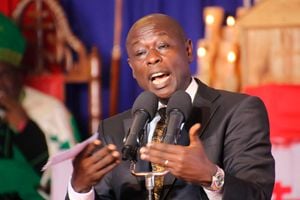Eyes on Epra ahead of new fuel prices

An attendant fuels a motor vehicle at OLA petrol station near Pandya Hospital in Mombasa County on July 1, 2023.
All eyes are on the energy regulator ahead of Sunday's announcement of new fuel prices, amid strong expectations that prices will fall for the second month in a row.
The Energy and Petroleum Regulatory Authority (Epra) will announce pump prices for the month ending February 14.
A litre of super petrol and diesel currently costs Sh212.36 and Sh201.47, respectively, in Nairobi in the pricing plan that expires at midnight Saturday.
In the pricing schedule announced on December 15 last year, Epra slashed pump prices by up to Sh5 per litre, the biggest cut since October 2021, reflecting the continued fall in global crude oil prices.
President William Ruto and Epra Director-General Daniel Kiptoo said last month that the drop in pump prices would continue into the New Year, reflecting the fall in prices in the global market.
“Prices will drop further in January. This is because fuel prices in the global market are falling,” Dr Ruto said last month.
Kiptoo told the Nation last month: “The drops will continue into the New Year in line with what we are seeing globally, but for now, we are past the toughest times.”
Global prices for Murban crude hit a six-month low of $73.5 per barrel mid last month, setting the stage for a fall in local pump prices.
Murban crude prices – the benchmark used by Epra for its monthly pricing cycles – have fallen amid slowing demand in the US and China and production cuts by the Organisation of the Petroleum Exporting Countries (OPEC).
The landed cost of super petrol fell the most by 16.1 per cent to $694.44 (Sh109,388) from $827.75 (Sh128,831) per cubic metre while that of diesel fell 5.43 per cent to $826.01 (Sh130,113) from $873.42 (Sh135,139) for cargoes used by Epra to set the current prices that expire Saturday.
The question of the exchange rate used to calculate fuel prices is also looming large, weeks after Energy and Petroleum Cabinet Secretary Davis Chirchir accused banks of quoting higher rates, which in turn denied consumers a further drop in pump prices.
Chirchir directed Epra to enquire from the Central Bank of Kenya (CBK) on the shilling to dollar exchange rate to be used, saying oil dealers were quoting an average rate that was higher, denying consumers a further reduction in fuel prices.
Sh157 to the dollar
“For the month obtained, if we employed Sh157 to the dollar but CBK tells us that the rate should be Sh154, then we shall claw in the next announcement on 14th. Why is one bank opening the spread at Sh160 to the dollar when the market should be at Sh153?” Chirchir asked.
But oil executives have remained tight-lipped on the matter, saying Epra can only use the actual prices at which they buy the dollar to cushion them against forex losses.
“We are aware of the communication by the CS over the dollar issue. But Epra can only use the actual prices quoted by the banks that purchase dollars from the market, otherwise relying on the CBK rate would throw us into losses,” said an executive who requested anonymity.
The exchange rate is a critical factor in determining prices and a sharp depreciation of the shilling has the potential to wipe out the gains expected from the fall in global crude oil prices.
However, it remains to be seen whether Epra will extend the fuel stabilisation scheme, which has partly helped to reduce local pump prices. In the current pricing scheme, the regulator has used super-consumers to cross-subsidise diesel and kerosene users.
Fuel price cross-subsidisation refers to setting higher prices for one variant, such as super, in order to lower the prices of diesel and kerosene.
A further drop in pump prices effective midnight will see prices fall below the Sh200 mark for the first time since September last year.
Fuel prices in Kenya crossed the Sh200 mark for the first time in the monthly cycle that ended on October 14 last year when a litre of super jumped to Sh211.64, diesel to Sh200.99 and kerosene to Sh202.61 per litre in Nairobi.
In other regions, fuel prices are highest depending on how far a place is from the port of Mombasa. This is due to transport costs, which Epra takes into account when setting prices.
For example, the most expensive fuel in the current price list is in Mandera County, where a litre of super costs Sh226.36, while diesel costs Sh215.47 and a litre of kerosene costs Sh213.06.
The expected fall in fuel prices will boost the government's efforts to curb inflation. Inflation – the measure of the cost of living – fell to 6.6 per cent last month from 6.8 per cent in November.
Kenya's economy is driven by diesel, highlighting why a fall in the cost of the commodity is expected to have a significant impact on inflation.
Energy and transport costs have a significant weighting in the basket of goods and services used to measure inflation in the country.
Manufacturers of goods, farmers, service providers and electricity generating firms all factor in the cost of diesel when setting prices for goods and services.
[email protected]





